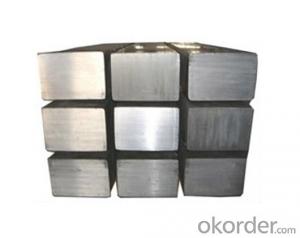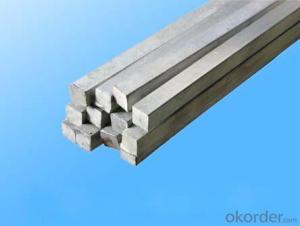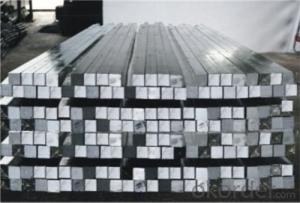Q195Cr High Quality Square Steel Bar
- Loading Port:
- Tianjin
- Payment Terms:
- TT OR LC
- Min Order Qty:
- 1000 m.t.
- Supply Capability:
- 100000 m.t./month
OKorder Service Pledge
OKorder Financial Service
You Might Also Like
Product Description:
Product Description:
In the production of steel products, steel is molded and reshaped with different machinery at different temperatures. One process is steel rolling, which involves metal stock passing through a pair of rolls. Rolling produces flat steel sheets of a specific thickness, and the process is classified according to the temperature at which the metal is rolled. If the temperature of the metal is above its recrystallization temperature, or the temperature at which the grain structure of the metal can be altered, then the process is termed as hot rolling. If the temperature of the metal is below its recrystallization temperature, the process is termed as cold rolling.
Like cold rolling, cold drawing is performed at room temperature, but instead of producing a flat object like a coke can, cold drawing makes steel into the form of a wire like the spokes of a wheel or a paper clip. To start the process, Steel is usual hammered and rolled so that it can be fit through a die; a tool that turns the steel mass into a wire. The room temperature steel is pulled through the die which reshapes it into a thinner shape while maintaining the same volume. It is similar to the idea of syrup flowing out of a bottle through a tube in that it changes shape but not volume, but instead of squeezing the metal, it is pulled out. In order to get the wire down to the right diameter, it usually requires more than one pass through different dies.
Colddrawn steel, steel covered carbon steel, excellent carbon steel, alloy structural steel, carbon tool steel, spring steel, bearing steel, tool steel, cold heading steel, free cutting steel, martensite stainless steel; products include all kinds of shapes round, square steel, hexagonal, flat steel and other conventional products, including various special-shaped steel products. In all types of colddrawn steel industry has been widely used, these areas include automotive, machine tools, furniture, standard parts, textile machinery, agricultural machinery, military industry and other industries.
The total assets of more than 40 million, as of the end of 2010 with fixed assets of 34 million, with 60 tons from 5 tons a chain drawing machine 10 sets, horizontal and inverted coiled wire drawing machine 5 sets, steel and plate production line of blasting, high-power ham stove, various straightening machine and cold rolling mill and other major equipment.
Usage/Applications
-The Square Bar is normally used as structure steel.
-Row material for other structure steel like steel angles, channels, I-beams, H-beams, etc…
Packaging & Delivery
-Packing Detail: The products can be packed in bundles by steel wires.
-Marks: We make tag marks and color marks. The tag marks with white background and red company logo will be tied up to each bundle of the products. The information is usually including basic information of products and company and other information requested by customers. As for color marks, we will paint both ends of bundles to make sure that it w
-Delivery Detail: 30~45 working days after receive buyer’s T.T. or L/C.
ill be more convenient for customers to distinguish them from other products.
- Q:Can a steel square be used for laying out a gazebo?
- Yes, a steel square can be used for laying out a gazebo. A steel square is a versatile tool commonly used in carpentry and construction for measuring and marking angles, making it useful for accurately setting up the foundation and layout of a gazebo.
- Q:Can a steel square be used for marking out tenons?
- Indeed, the utilization of a steel square is suitable for the purpose of marking out tenons. This versatile tool, commonly referred to as a framing square or carpenter's square, is extensively employed in the fields of woodworking and carpentry to attain accurate measurements and establish precise angles. In the process of marking out tenons, which are the protruding ends of a wooden piece designed to fit into a mortise, the steel square proves to be an invaluable resource for ensuring precise and perpendicular cuts. By aligning the square with the wood's edge and marking lines along its straight boundaries, woodworkers can consistently and precisely fashion their tenons. The robust construction and straight edges of this square render it an ideal instrument for marking out tenons as well as other woodworking joints.
- Q:How do you use a steel square to measure and mark 213.75-degree angles?
- To use a steel square to measure and mark a 213.75-degree angle, you would follow these steps: 1. Begin by aligning the long edge of the steel square with the reference line or surface where you want to create the angle. Ensure that the square is firmly held in place to prevent any movement during the marking process. 2. Locate the 0-degree mark on the steel square, which is typically found at the intersection of the long edge and the shorter perpendicular edge. Make sure this mark is lined up precisely with the reference line or surface. 3. Next, identify the degree scale on the steel square. This scale usually ranges from 0 to 90 degrees, with increments of 1 or 2 degrees marked along the edge of the square. 4. To measure a 213.75-degree angle, start by aligning the 0-degree mark with the reference line or surface. Then, move your gaze along the degree scale until you reach the 213.75-degree marking. This marking may not always be explicitly labeled, so you may need to estimate the position between two marked degrees. 5. Once you have located the correct degree measurement, make a small mark or notch at that point on the reference line or surface using a pencil or any other suitable marking tool. This mark will indicate the desired angle. 6. Finally, use a straight edge or a ruler to connect the marked point with the reference line or surface, creating the 213.75-degree angle. Remember, precision is crucial when using a steel square to measure and mark angles. Ensure that the square remains securely in place and take your time to accurately locate the desired degree measurement.
- Q:How do you use a steel square to lay out a diagonal line?
- Achieving a diagonal line using a steel square involves following a series of straightforward steps. Begin by positioning the steel square on your chosen work surface or material, ensuring that one edge of the square aligns perfectly with the material's edge. The longer arm of the square should be pointing in the desired direction of the diagonal line. Next, ensure that the shorter arm of the square is aligned with the material's edge. This will act as a guide for your line. Now, take a pencil or marking tool and firmly press it against the longer arm of the square at the desired angle for your diagonal line. Maintain a consistent angle and ensure that the pencil is securely against the steel square. While keeping the pencil against the square, glide it along the longer arm, ensuring continuous contact with the square. This action will create a straight and diagonal line on the material. Continue sliding the pencil along the square until the desired length of the diagonal line is achieved. It is crucial to maintain consistent pressure and angle throughout the process to obtain accurate results. Once the line is completed, double-check its accuracy and make any necessary adjustments. You can now rely on this diagonal line as a guide for any further measurements or cuts required on the material. Using a steel square to lay out a diagonal line is a straightforward and reliable technique that guarantees precision and accuracy in your work.
- Q:How do you use a steel square for creating precise spline joints?
- To use a steel square for creating precise spline joints, first, measure and mark the desired length on both pieces of wood. Then, align the steel square against the edge of the wood, ensuring it is perpendicular to the surface. Next, draw a line along the edge of the steel square using a pencil or a marking knife. Repeat this process on both pieces of wood. Finally, align the marked lines and cut along them to create precise spline joints.
- Q:Can a steel square be used for checking the alignment of door frames?
- Checking the alignment of door frames can be done using a steel square. A steel square, which is also referred to as a combination square, is a tool with a ruler and an adjustable square head. It is commonly utilized in woodworking and carpentry to measure, mark, and examine angles. To check the alignment of a door frame with a steel square, the first step is to ensure that the square is set at a 90-degree angle. Afterward, the square should be placed against the inner edge of the door frame, ensuring that it is flush with both the top and side of the frame. By visually inspecting the alignment of the square with the frame, it is possible to determine if the frame is perfectly square or if any adjustments are required. Additionally, a steel square can also be employed to check the hinge side of the door frame. By placing the square against the inner edge of the frame and extending it along the frame's length, it is possible to ascertain if it is straight and free from warping. This is crucial for the proper installation and smooth operation of the door. In conclusion, a steel square is a valuable tool for checking the alignment of door frames. Its versatility and precision make it a dependable choice for carpenters, contractors, and homeowners alike.
- Q:Can a steel square be used for checking the plumbness of a beam?
- No, a steel square is not typically used for checking the plumbness of a beam. A plumb bob or a spirit level would be more suitable tools for this task.
- Q:Can a steel square be used for marking out lap joints?
- Absolutely, lap joints can be easily marked out using a steel square. Carpenters and woodworkers frequently rely on the versatility of this tool for measuring and indicating right angles. In the realm of woodworking, lap joints are commonly utilized, and a steel square serves as a precise instrument to mark the exact spots where the two wooden pieces will intersect. By aligning the square with the wood's edges, you guarantee a precise marking and cutting process, ultimately leading to a snug and flawless fit. The steel square acts as a dependable and precise reference point for marking out lap joints, making it an indispensable tool in this regard.
- Q:How do you use a steel square to determine the length of a staircase?
- To use a steel square to determine the length of a staircase, you would need to measure the rise and run of each step. The rise is the vertical height from one step to another, while the run is the horizontal distance from the front edge of one step to the next. By multiplying the rise and run measurements, you can calculate the length of each step and add them together to determine the overall length of the staircase.
- Q:Can a steel square be used for making 90-degree corners?
- Yes, a steel square can be used for making 90-degree corners.
1. Manufacturer Overview |
|
|---|---|
| Location | |
| Year Established | |
| Annual Output Value | |
| Main Markets | |
| Company Certifications | |
2. Manufacturer Certificates |
|
|---|---|
| a) Certification Name | |
| Range | |
| Reference | |
| Validity Period | |
3. Manufacturer Capability |
|
|---|---|
| a)Trade Capacity | |
| Nearest Port | |
| Export Percentage | |
| No.of Employees in Trade Department | |
| Language Spoken: | |
| b)Factory Information | |
| Factory Size: | |
| No. of Production Lines | |
| Contract Manufacturing | |
| Product Price Range | |
Send your message to us
Q195Cr High Quality Square Steel Bar
- Loading Port:
- Tianjin
- Payment Terms:
- TT OR LC
- Min Order Qty:
- 1000 m.t.
- Supply Capability:
- 100000 m.t./month
OKorder Service Pledge
OKorder Financial Service
Similar products
New products
Hot products
Related keywords


























